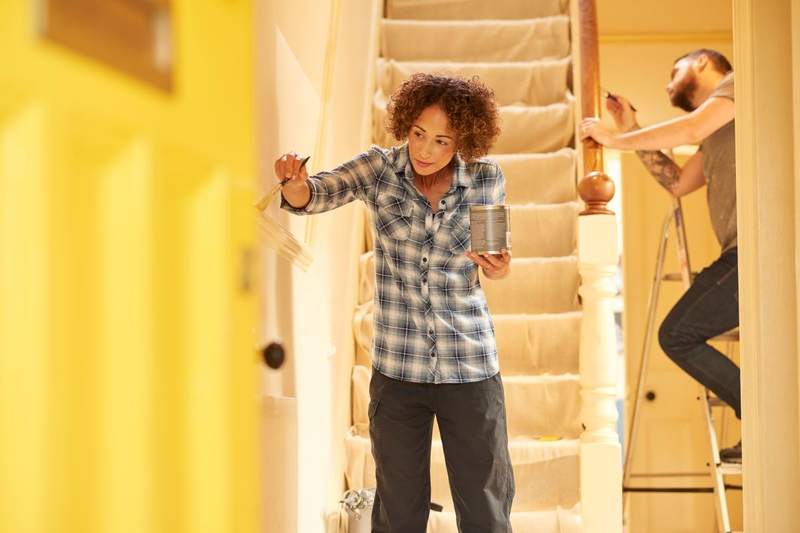We adore our cats and dogs. Those of us who proudly wear the badge of pet owner love our fur babies, consider them members of the family and ferociously defend them. Our love is unconditional, and we may have even carried out home renovations to accommodate our pets. In fact, some of the cost of those renovations you made might be recouped by value added to your home’s sale price.
On the flip side, we know that pets are a luxury and, at times, an expensive one. One of those times is when you’re trying to sell a house. You may have become accustomed to your animal’s “musk,” only to be told by your listing agent that buyers will be turned off by the pet smells in your home within moments of entering your home.
Don’t worry. We’ve got some tips that can help you maximize the value of creating a pet-friendly home and also help you prepare to show your pet-filled home.
See What You Qualify For
You can get a real, customizable mortgage solution based on your unique financial situation.
Selling A Home With Cats And Dogs: How Big Of A Problem Is It?
How much of an issue your pet will present depends in large part on whether your home is located in an area that is a seller’s market. In a seller’s market, there are more buyers than there are houses to buy, so buyers can’t afford to be too finicky. At the moment, large swathes of the U.S. are experiencing overheated seller’s markets.
If you live in a buyer’s market, on the other hand, you’ll find that there are far fewer buyers than there are sellers. In the aftermath of the 2008 financial crisis, there were far fewer buyers than sellers, and those buyers could afford to be extremely picky. If you live in one of those markets, the last thing you want to do is offend the senses of potential buyers by showing your home before removing all traces of your pet.
See What You Qualify For
Buy A Home
Discover mortgage options that fit your unique financial needs.

Refinance
Refinance your mortgage to have more money for what matters.
Tap Into Equity
Use your home’s equity and unlock cash to achieve your goals.
Selling A Home With Cats And Dogs: The Good News
Estimates of pet ownership vary, but according to the U.S. Census Bureau, almost one half of American households own pets (48.4%). In fact, in the most pet-loving city – Tucson, Arizona – over 60% of households have at least one pet.
As income and house size increases, the Census Bureau found, so does our rate of pet ownership. The amount spent on pet-related renovations has increased as well. According to the National Association of REALTORS® (NAR), 52% of animal owners have undertaken renovations to accommodate their pets. Owners report a Joy Score of 9.4 (out of 10) after animal-related renovations are completed.
When 61% of American households include pets or plan to add a pet to their family soon, not only are there more animal lovers than not, but animal owners often put their pets front and center in their home buying decisions. The NAR study also found that 31% percent of dog and cat owners “often” or “very often” refuse to submit an offer on a home unless it’s an ideal match for their pets.
If you’ve invested in any of these features, you’ll want to make sure prospective home buyers who are also animal lovers know about them. That doesn’t mean you have to market exclusively to pet owners – folks who don’t have pets will also appreciate your fenced-in yard and laminate flooring, and you don’t want to alienate them.
Here are the three most important features to most animal owners.
Fenced-In Yard
The number one feature, at 78%, that dog owners want in a home is a fenced-in yard. Particularly among dog owners who currently live in dense, urban areas, a fenced-in yard can seem like an unimaginable luxury.
If you’ve already fenced your yard in, it’ll be an important amenity to highlight in your sales literature. Make sure to mention if your yard is securely fenced in, as opposed to partially fenced. If you’ve installed an electronic fence, be sure to note that as well.
Laminate Flooring
Our pets are our little angels, but to our floors, not so much. Between accidents and the clickety-clack of their paws, our hardwood floors are no match for our critters. Coming in at 76% among animal owners, laminate flooring is the solution to a forever problem.
Animal Washing Station
A dedicated washing area for animals is high on the wish list among animal owners looking for a new home, although it doesn’t seem to rank as heavily – at 35% – in importance among current owners. Nonetheless, if you have a dedicated space for conveniently washing your animals, perhaps in a basement or mudroom, be sure to highlight it. People who don’t own pets might look puzzled, but anyone who’s come home from the park with a dog who rolled in mud or worse will immediately reach for their checkbook.
Selling A Home With Cats And Dogs: The Bad News
Those of us with pets know that keeping a pet home 100% odor- and hair-free is more of an aspiration than an attainable goal. In fact, NAR reports that 67% of REALTORS® said pet ownership has a “moderate to major” impact when selling a home. While it’s not clear from the report, it seems that in this case, “impacts” refers to negative impacts.
How do you keep beloved pets from costing you a small fortune when you sell your house?
Tips On How To Minimize Pet Damage When Preparing To Show Your Home
According to the real estate agents surveyed for NAR, there are six steps you can take to make sure your home is shown in its best possible light to the greatest number of potential buyers.
[Note: This information was taken from the chart on page 21 of the NAR report referenced throughout.]
Always | Sometimes | Not Usually | |
|---|---|---|---|
Replacing anything that has been damaged | 67% | 30% | 3% |
Cleaning home to remove animal scents | 65% | 32% | 3% |
Taking animals out during home showing | 67% | 32% | 3% |
Having home professionally cleaned | 41% | 49% | 10% |
Removing pet objects (food dishes, cat litter or animal crate) | 37% | 42% | 21% |
Replacing carpet and flooring | 9% | 76% | 16% |
Here are steps you can take to minimize the negative impression pets have on potential home buyers.
Find A Mortgage Today and Lock In Your Rate!
Get matched with a lender that will work for your financial situation.
Repair Any Damage
When you’re getting ready to show your home, you’ll want to remove all evidence of yourself or your family (including pets) from your surroundings. And that means doing those little home repairs that you probably don’t notice anymore. Here’s a list to get you started:
- Repair or replace chewed stair railings and steps, scratched doors and door facings
- Repair or replaceshredded draperies and scratched window screens or ledges
- Repaint anything that needs painting
- Fill in patchy flower beds with new plants
- Sod or plant grass to cover bald spots in the yard. If your budget allows, consider hiring a professional landscaping service to refresh your lawn and up your curb appeal.
Clean Your Home To Remove Animal Scents
Pet odors are problematic. There are hundreds of products and air purification devices that say they remove pet odors, but ask any pet owner and they’ll tell you that pet odors have won many rounds against cleaning products. Avoid relying too heavily on air fresheners because some people are allergic to these and, at best, they merely mask the problem.
Have Your Home Professionally Cleaned
This is standard advice for preparing your home for sale, but it’s especially important if you have pets living in your home.
For the stubborn smells and stains that come with pet ownership, the best solution is to have your home professionally cleaned. Your real estate agent encounters unwelcome smells and sights all the time, and should be an excellent source for cleaning referrals. If you’re going to deodorize the home on your own, try enzyme cleaners instead.
Hiring a professional to deep-clean the floors might also be a good idea. Any floor that supports kids or pets all day long deserves a deep cleaning and a restorative waxing.
Take Your Pet Out During Home Showing
Having your pets at home during a showing or, worse, an open house, is not a good thing. Remember, your goal is to remove all traces of yourself from the home when it’s being shown. A pet is a very large trace of you.
More importantly, just because you think your home will most appeal to an animal lover doesn’t mean you want to make it unattractive to those who aren’t as fond of animals. And nothing will put one of these people off faster than having your dog jump on them, or a sneezing fit courtesy of your cat.
If you’re still occupying the house, consider boarding your pets at a kennel on days when a showing is scheduled. You could also consider asking a friend or relative to care for them while your home is being shown.
If at all possible, try to reschedule any showing set for a time when you simply can’t remove the animals from your home. If you must keep your pets at home during a showing, put them in carriers or cages and leave a note for visitors to not disturb them. At the very least, warn the home buyer that the animals will be at home during the showing and explain how they’re secured, then let them decide whether they’d like to proceed. Try to place your pets somewhere other than the kitchen, bathroom or living room.
Remove Pet Objects
Keep cat litter boxes and doggie pads clean and out of sight. Ditto for food dishes, animal food, cat litter or any animal crates, along with all pictures of you, your family or your pet. You want prospective buyers to see themselves – not you – in your home.
Replace Carpet And Flooring
If you’ve already installed laminate flooring, you’re way ahead of the game. If you’re not planning on selling immediately, this might be an upgrade worth considering if your pets have done a number on your floors or carpets.
Savvy buyers will instantly notice pet stains on the carpets and hardwood floors. If the stains aren’t removable, consider replacing the carpet or refinishing the floors. If you can’t or don’t want to undertake that project, consider offering a discount to the buyers that will pay for new flooring or carpeting.
Get Tech Help To Sell Your Pet-Filled Home
The pandemic has increased the opportunities to complete sales online. More people than ever have bought homes sight (and smell!) unseen, and you can use this to your advantage while being completely honest with prospective buyers.
Online Sales
With home sales moving online, pictures are becoming increasingly more important to potential buyers. Getting a professional photographer to take those pictures can help in many ways. First, you can get the best possible photos of your home, and particularly the areas that are of interest to animal lovers. Next, potential buyers will form their first impressions of your home from those photos.
You can control that image, in consultation with your real estate agent, who will know best what buyers are looking for. That doesn’t mean the pictures should be unethically altered, but rather that they should be taken when your home is at its best – whether that means catching the best natural light or depicting the brand-new laminate flooring.
Virtual Staging
If your home has sustained heavy damage from pets, but you can’t or won’t undertake those repairs, it may be hard to figure out how to stage your home for an in-person sale. Traditional staging, or getting your home ready to show in real life, can be costly and difficult.
You may want to consider a newer technique called virtual staging. Using the digital pictures of your home, graphic designers and interior designers work to show the home’s potential by altering the photos to show how the home will look with new flooring or new furniture.
Of course, sellers using this technique must disclose that the home does not look like the photo at present, and must truthfully represent the home’s actual condition.
Cash Buyers
Increasingly, real estate sales are being carried out online. Cash buyers, sometimes called iBuyers, are increasingly willing to pay near top dollar in cash to make buying homes easier and faster. These all-cash transactions, once used almost exclusively by flippers or investors looking for bargains, are now becoming more popular even among those looking for their next home.
Again, you’ll have to be candid about any damage done by your pets, but combined with virtually staged photos and a willingness to offer seller concessions where appropriate, you might find it’s worth accepting a discounted offer to skip the in-person staging process altogether.
Selling Your Home: Other People’s Dogs
What if the animal in question is a neighbor’s very barky dog?
A buyer may be very concerned about a noisy neighborhood dog, and if a home inspector or home appraiser hears incessant dog barking, they will include that information in their reports. Does that mean you have a seller’s duty to disclose that situation to buyers?
Generally speaking, the answer is no, but you need to check the laws of your state to be sure. Your real estate agent should be able to answer this question to your satisfaction.
If you’re specifically asked by a buyer whether there are any recurring noise issues in your area, though, you can’t lie. A buyer may sue you later if you made a material misrepresentation about your home during the sales process.
Strategies For Showing Your Home With A Barking Neighborhood Dog
Ask That The Dog Be Put Inside During Showings
If you have a good relationship with your neighbor, your first approach should be friendly, direct and offer a solution at your expense. For example, if your home is scheduled to be shown on a particular day, ask your neighbor if they could take the dog inside while the buyers are looking at the house.
If the neighbors leave their dogs outside during work, you might ask if they would consider allowing you to treat their pet to a session at a doggie day care facility, or if they could make another arrangement to temporarily remove the dog.
Seek Legal Remedies
If this is a problem you’re anticipating, you should consult any noise ordinances that may be in place where you live. If the barking continues for a specified amount of time, you might consider reporting the situation to your town or city’s animal control. If that doesn’t help, you may need to contact an attorney to look into seeking legal relief through a lawsuit. The neighbor will have to disclose whether they’re facing any lawsuits as part of the Seller’s Disclosure when they decide to move, so the threat of a lawsuit may convince them to solve the problem.
The Bottom Line: When Selling Your Home With Pets, Cats And Dogs Aren’t Always Our Best Friends
But we love them anyway! They’ll always be a part of our households, smells and all. When it comes to selling, though, the key is to highlight the pet-friendly positives while eliminating the negatives when you show the home.
See What You Qualify For
You can get a real, customizable mortgage solution based on your unique financial situation.

Victoria Araj
Victoria Araj is a Staff Writer for Rocket Companies who has held roles in mortgage banking, public relations and more in her 15-plus years of experience. She has a bachelor’s degree in journalism with an emphasis in political science from Michigan State University, and a master’s degree in public administration from the University of Michigan.











